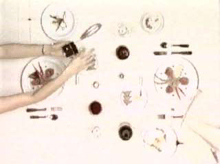|
ELIZABETH
DILLER, RICARDO SCOFIDIO
http://www.diacenter.org/dillerscofidio/
| |
 |
| |
|
 |
I995, Indigestion |
| |
|
| |
|
Indigestion
Indigestion blends together the genres of the film noir, installation
art and interactive games. It is comprised of an interactive video
and a virtual environment, linked together electronically. It shows
two people having dinner. An image of the table seen in a low-angle
shot is projected onto a horizontal screen, placed roughly at the
height of an ordinary table. The dialogue refers to some unspecified
crime, and all we can see are the movements of the hands of the
two diners. An interface device gives the visitor a selection of
stereotyped characters. The action is continuous, varying simply
according to the characters at the table. In counterpoint to the
static perspective of the projected table, another moving and dynamic
perspective magnifies the surface of the table, revealing another
micro-drama. Using a point and click feature on the navigation device,
the spectator begins to read the table as a forensic surface of
shifting information and material proofs, constantly in conflict
with the piece’s dialogue. The two simultaneous modes of representation
are not cumulative. Rather, they produce conflicting narratives
that remain inconclusive and "indigestible".
The view as presentation: Slow
House
The Slow House project by Elizabeth Diller and Ricardo Scofidio
grew out of some thoughts about the view, always seen as an extra
value in real estate terms. It appears, for example, that the positioning,
orientation and configuration of holiday homes all aim at structuring
the visual field as seen from the inside, in other words, at structuring
the view. The technology of high strength glass has led to a technological
modification of the view. The view is only recognized as such when
it is framed by a picture window, making possible the appropriation
of the landscape within the domestic interior. But when the vision
of the ocean or of the horizon is not blocked by any obstacle, then
the contemplation of the curves of the planet takes on new values
— as does the house too. In Slow House, a long corridor leads
from the entrance to an immense picture window on which an electronic
view is displayed. A remote control system makes it possible to
zoom in or enlarge the field of vision, and to memorize whichever
parts one likes. The view becomes a leisure pursuit, and the hidden
technology leads to a new social use of the window as object.
The view as presentation: Jump
Cuts
Jump Cuts is an installation which has been designed for a Silicon
Valley cinema. It offers recorded sequences, viewed on a liquid
crystal display screen and shown in one of two modes: a transparent
mode or a translucent mode. The same principle was applied in another
project for the CNN Center, a 1960s-style building in reinforced
concrete. A large number of liquid crystal panels were set up inside
the vast atrium of the building, showing video images on a grandiose
scale. The virtual accessibility of this space is endlessly called
into question by alternating real view and view transmitted live
from inside the building.
|

